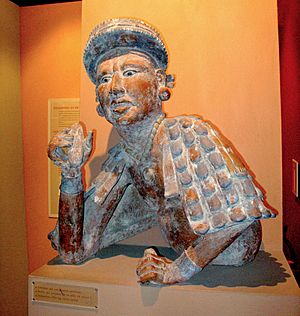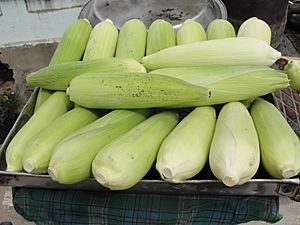Pre-Columbian cuisine facts for kids
Pre-Columbian cuisine is all about the food and drinks eaten by people in the Americas long ago. This was before Christopher Columbus arrived and brought new foods from Europe. Even before Columbus, many amazing cultures lived here. These included the Aztec, Mayan, Incan, and Native American peoples.
Farming changed everything for these groups. It helped them stop hunting all the time and settle down in one place. A super important crop was maize (corn), which first grew in central Mexico. Other key plants grown in the Americas were amaranth, wild rice, and lima beans.
Contents
Food from Different Cultures
Mayan Food Traditions
Most Mayan meals were made from maize dough. They used it for tortillas and tamales. Mayans ground their ingredients using a stone slab and a rolling pin-like tool. The ground maize then became their tortillas.
Popular drinks included chocolate, made from ground cacao and cinnamon mixed with water or milk. They also drank atoles and pinoles, which came from ground seeds. The Mayans were probably the first to write about cacao. A special tradition was making unique tamales for big events. Corn was also a symbol of life and health for them. Each family kept one ear of corn, blessing it at harvest time instead of planting or eating it.
Incan Food Traditions
The Incan Empire was in what is now Peru. Both the potato and the sweet potato first grew in the Incan region. Maize was also farmed there as early as 3000 B.C. Another important Incan food, now popular again, is quinoa.
A traditional meat for the Incans was the Peruvian guinea pig, which they saw as a special treat. The Incan people also drank chicha de jora, a traditional drink.
They used clay pots called ollas de barro because they added a special flavor to food. Families would celebrate ranch anniversaries with outdoor cooking pits called pachamanca. These big feasts included meat, root vegetables, and corn.
Native American Food Traditions
Native American food often involved hunting wild animals, gathering wild plants, and growing fruits and vegetables. The Southwestern United States, including Arizona and New Mexico, was home to many Native American groups. The Puebloan people became farmers, growing corn, beans, and squash along the Rio Grande. Other groups, like the Navajo and Apache, continued to hunt and gather.
For almost all tribes, maize was the most important food. Beans and squash were also highly valued. These three crops, called the "Three Sister Crops," were often planted together. They helped each other grow. Chokecherries were also important, especially for the Blackfoot and Cheyenne tribes.
Many tribes used their knowledge of nature to hunt. Fish, shellfish, and small animals were key foods for tribes in the Pacific Northwest and Alaska. Plains tribes hunted bison a lot. They used bison for meat, clothing, and tools. Every part of the animal was used.
Women played a big role in food for all tribes. They were in charge of preparing and gathering food. They used tools made from animal bones, like stirring sticks and ladles. Kettles were the main way of cooking. They also used clay bowls and baskets. To avoid hunger in winter, Natives learned to preserve food by drying, smoking, and salting it.
Important Crops of the Americas
Maize: The Staple Crop
This crop was first farmed by the Aztec, Mayan, and Incan cultures. It was incredibly important and is seen as the most vital food for native peoples of the Americas. Growing maize allowed people to stop hunting and settle down. It was so important that native people often saw it as godlike. Maize appeared in their art and pottery. It was central to many Pre-Columbian religions, much like bread in Western cultures. Some beliefs even said that humans were made from corn. Research shows maize was also a key food in the Caribbean before Columbus.
Phaseolus Beans: Maize's Best Friend
This bean was very important because it worked so well with maize. It helped maize in farming, nutrition, and cooking. The bean added nitrogen to the soil, which helped maize grow. Also, combining beans and maize created a meal rich in protein. This made them a reliable food source.
Capsicum Peppers: Spice and Medicine
These peppers were also often shown in pottery. They were used for many medicinal purposes.
Starches: Root Vegetables
The importance of cassava, potato, and sweet potato is clear from how often they appear in sculptures and art. Both potatoes and sweet potatoes were first grown by the Incas.
Blueberry: A Sweet Treat
This fruit was mixed with dried meat to make a dish called pemmican. This was common among many Native American tribes.
Cacao: The Chocolate Plant
The seeds of the cacao plant were so valuable to the Aztecs that they used them as money. Cacao was also common in their pottery. The chocolate from these seeds was used to make many different drinks. Cacao beans could only grow well in specific places. So, they were often grown in large farms in those regions.
Cactus: A Desert Plant
Cactus plants also came from the Americas. Today, they are often used for their fruit, as vegetables, and even for dye.
Chokecherries: Plains Tribe Food
These cherries were important for Plains tribes of Native Americans. They would pound them and dry them in the sun.
Mannomi: Wild Rice
This wild rice, found in the Great Lakes area of America, was very important for the Anishinaabe tribe.
A Look Back in Time
15,000-13,000 BCE: First Arrivals
The first big-game hunters came into North America. These people traveled from Siberia across the Bering Plain. They then spread out across the Americas, leading to many different cultures.
13,000-10,000 BCE: Animals Disappear
Many large mammals started to die out. This might have happened because humans hunted too many of them.
9500-2000 BCE: Smaller Animals and Plants
People started hunting smaller animals, including fish. They also began to gather plants for food. This led to people forming settlements along the Pacific Ocean coast.
3000-1200 BCE: Farming Begins
Agriculture began with making flour and growing maize. This allowed people to live a more settled life. Spiritual beliefs also started to form.
After 900 BCE: Maize Takes Over
Most societies in Mesoamerica (like Mexico and Central America) began to rely on maize as their main food source.
1100 CE: The Hopi and Corn
The Hopi people had farms mostly based on maize. Their beliefs were deeply connected to nature and the "corn mother," who they believed gave them life.
1519 CE: Cortes Meets the Aztecs
Hernan Cortes found the Aztec Empire in what is now Mexico. He was amazed by their deep knowledge of health and medicine.
How Ancient Foods Affect Us Today
Many crops from the Americas are super important in today's world. Maize is one of the most valuable. Its worth is even greater than the silver and gold the Spanish took. It is the most important grain worldwide. Over 800 million tons are produced globally. Maize is a main ingredient in animal feed, human food, sweeteners, and even gasoline. For example, maize is still the base of much Mexican food.
Many other crops from the Americas spread around the world thanks to Christopher Columbus. The peanut became widely used in Africa. Capsicum peppers are a big part of Asian cooking. Tomatoes are essential to Italian food and are common everywhere. The potato is one of the most important vegetables. Fruits like pineapple, papaya, and strawberry also spread widely.
Industrial crops, like cotton, rubber, quinine, and tobacco, are now grown for non-food uses. Cotton is common in clothes. Rubber has many industrial uses. Quinine helped fight malaria. Tobacco, however, caused many health problems.
Mexican Cuisine Today
Just like the ancient cultures of Mexico, modern Mexican food relies heavily on corn, beans, and peppers. Corn is still as important in Mexico today as it was in the past. It remains the most essential food product and is used in many ways. Beans are also eaten with corn, just like long ago. Other native plants still common in Mexican food include tomatoes, squash, onions, tomatillos, avocados, and cactus.



